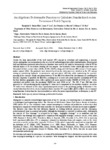Please use this identifier to cite or link to this item:
http://www.alice.cnptia.embrapa.br/alice/handle/doc/1051668Full metadata record
| DC Field | Value | Language |
|---|---|---|
| dc.contributor.author | OTTONI FILHO, T. B. | pt_BR |
| dc.contributor.author | LEAL, I. F. | pt_BR |
| dc.contributor.author | MACEDO, J. R. de | pt_BR |
| dc.contributor.author | REIS, B. C. B. | pt_BR |
| dc.date.accessioned | 2016-08-25T11:11:11Z | pt_BR |
| dc.date.available | 2016-08-25T11:11:11Z | pt_BR |
| dc.date.created | 2016-08-25 | pt_BR |
| dc.date.issued | 2016 | pt_BR |
| dc.identifier.citation | Journal of Agricultural Science, v. 8, n. 8, p. 158-170, 2016. | pt_BR |
| dc.identifier.uri | http://www.alice.cnptia.embrapa.br/alice/handle/doc/1051668 | pt_BR |
| dc.description | Despite the large applicability of the field capacity (FC) concept in hydrology and engineering, it presents various ambiguities and inconsistencies due to a lack of methodological procedure standardization. Experimental field and laboratory protocols taken from the literature were used in this study to determine the value of FC for different depths in 29 soil profiles, totaling 209 soil samples. The volumetric water content (θ) values were also determined at three suction values (6 kPa, 10 kPa, 33 kPa), along with bulk density (BD), texture (T) and organic matter content (OM). The protocols were devised based on the water processes involved in the FC concept aiming at minimizing hydraulic inconsistencies and procedural difficulty while maintaining the practical meaning of the concept. A high correlation between FC and θ(6 kPa) allowed the development of a pedotransfer function (Equation 3) quadratic for θ(6 kPa), resulting in an accurate and nearly bias-free calculation of FC for the four database geographic areas, with a global root mean squared residue (RMSR) of 0.026 m3·m-3. At the individual soil profile scale, the maximum RMSR was only 0.040 m3·m-3. The BD, T and OM data were generally of a low predicting quality regarding FC when not accompanied by the moisture variables. As all the FC values were obtained by the same experimental protocol and as the predicting quality of Equation 3 was clearly better than that of the classical method, which considers FC equal to θ(6), θ(10) or θ(33), we recommend using Equation 3 rather than the classical method, as well as the protocol presented here, to determine in-situ FC. | pt_BR |
| dc.language.iso | eng | eng |
| dc.rights | openAccess | eng |
| dc.subject | Capacidade de campo | pt_BR |
| dc.subject | Drenagem interna | pt_BR |
| dc.subject | Funções de pedotransferência | pt_BR |
| dc.title | An algebraic pedotransfer function to calculate standardized in situ determined field capacity. | pt_BR |
| dc.type | Artigo de periódico | pt_BR |
| dc.date.updated | 2016-08-25T11:11:11Z | pt_BR |
| riaa.ainfo.id | 1051668 | pt_BR |
| riaa.ainfo.lastupdate | 2020-09-02 -03:00:00 | pt_BR |
| dc.identifier.doi | 10.5539/jas.v8n8p158 | pt_BR |
| dc.contributor.institution | THEOPHILO B. OTTONI FILHO, UFRJ; ISAIAS F. LEAL, UFRJ; JOSE RONALDO DE MACEDO, CNPS; BRUNO C. B. REIS, UFRJ. | pt_BR |
| Appears in Collections: | Artigo em periódico indexado (CNPS)  | |
Files in This Item:
| File | Description | Size | Format | |
|---|---|---|---|---|
| 2016026.pdf | 357,61 kB | Adobe PDF |  View/Open |









